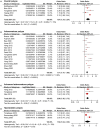Association Between H. pylori Infection and Colorectal Polyps: A Meta-Analysis of Observational Studies
- PMID: 35118081
- PMCID: PMC8803908
- DOI: 10.3389/fmed.2021.706036
Association Between H. pylori Infection and Colorectal Polyps: A Meta-Analysis of Observational Studies
Abstract
Background: It has been suggested that Helicobacter pylori (H. pylori) infection is associated with hypergastrinemia and proliferation of colorectal mucosa via direct stimulation, dysbiosis of the gut microbiome, and changes in the gut microbiome, all of which may lead to the formation of colorectal polyps. However, the consensus remains lacking regarding whether H. pylori infection is independently associated with colorectal polyps and whether the association differs according to histological type of colorectal polyps. To summarize the current evidence regarding the relationship between H. pylori infection and colorectal polyps, we conducted a meta-analysis of related observational studies according to the histological types of colorectal polyps.
Methods: Observational studies investigating the association between H. pylori infection and colorectal polyps using multivariate analyses were included by search of PubMed, Embase, and Web of Science. A random-effects model was adopted to combine the results.
Results: Seventeen studies that include 322,395 participants were analyzed. It was shown that H. pylori infection was independently associated with overall colorectal polyps (odds ratio [OR]: 1.67, 95% CI: 1.24-2.24, p < 0.001; I 2 = 73%). According to the histological type of colorectal polyps, H. pylori infection was independently associated with adenomatous polyps (APs; OR: 1.71, 95% CI: 1.47-1.99, p < 0.001; I 2 = 86%), advanced APs (OR: 2.06, 95% CI: 1.56-2.73, p < 0.001; I 2 = 0%), and hyperplastic polyps (HPs; OR: 1.54, 95% CI: 1.02-2.30, p = 0.04; I 2 = 78%). Evidence based on only one study showed that H. pylori infection was not associated with sessile serrated polyps (SSPs; OR: 1.00, 95% CI: 0.93-1.07, p = 0.99).
Conclusions: Current evidence from case-control and cross-sectional studies suggested that H. pylori infection was independently associated with colorectal APs, advanced APs, and HPs, but not with SSPs. These findings suggested H. pylori infection may be a possible risk factor of colorectal polyp, which is important for the prevention of colorectal polyp in the adult population.
Keywords: H. pylori infection; adenomatous polyps; colorectal polyps; hyperplastic polyps; meta-analysis.
Copyright © 2022 Lu, Wang, Ke, Wang, Wang, Li, Wang and Wang.
Conflict of interest statement
The authors declare that the research was conducted in the absence of any commercial or financial relationships that could be construed as a potential conflict of interest.
Figures



Similar articles
-
Helicobacter pylori infection and normal colorectal mucosa-adenomatous polyp-adenocarcinoma sequence: a meta-analysis of 27 case-control studies.Colorectal Dis. 2014 Apr;16(4):246-52. doi: 10.1111/codi.12290. Colorectal Dis. 2014. PMID: 23692360
-
Association of Helicobacter pylori infection with colorectal polyps and malignancy in China.World J Gastrointest Oncol. 2020 May 15;12(5):582-591. doi: 10.4251/wjgo.v12.i5.582. World J Gastrointest Oncol. 2020. PMID: 32461789 Free PMC article.
-
The effect of eradicating Helicobacter pylori infection on the course of adenomatous and hyperplastic gastric polyps.Eur J Gastroenterol Hepatol. 1999 Jul;11(7):727-30. doi: 10.1097/00042737-199907000-00008. Eur J Gastroenterol Hepatol. 1999. PMID: 10445791
-
Meta-analysis of the Correlation between Helicobacter Pylori Infection and the risk of Colorectal Neoplasia.Altern Ther Health Med. 2024 Aug;30(8):92-97. Altern Ther Health Med. 2024. PMID: 38290458
-
Helicobacter pylori infection and the risk of colorectal carcinoma: a systematic review and meta-analysis.Minerva Med. 2019 Oct;110(5):464-470. doi: 10.23736/S0026-4806.19.05942-1. Minerva Med. 2019. PMID: 31368293
Cited by
-
Atrophic gastritis rather than Helicobacter pylori infection can be an independent risk factor of colorectal polyps: a retrospective study in China.BMC Gastroenterol. 2023 Jun 19;23(1):213. doi: 10.1186/s12876-023-02764-w. BMC Gastroenterol. 2023. PMID: 37337163 Free PMC article.
-
Association between Helicobacter pylori Infection and Nasal Polyps: A Systematic Review and Meta-Analysis.Microorganisms. 2023 Jun 14;11(6):1581. doi: 10.3390/microorganisms11061581. Microorganisms. 2023. PMID: 37375083 Free PMC article.
-
Construction and validation of machine learning-based predictive model for colorectal polyp recurrence one year after endoscopic mucosal resection.World J Gastroenterol. 2025 Mar 21;31(11):102387. doi: 10.3748/wjg.v31.i11.102387. World J Gastroenterol. 2025. PMID: 40124266 Free PMC article.
-
Effects of Helicobacter pylori infection on intestinal microbiota, immunity and colorectal cancer risk.Front Cell Infect Microbiol. 2024 Jan 26;14:1339750. doi: 10.3389/fcimb.2024.1339750. eCollection 2024. Front Cell Infect Microbiol. 2024. PMID: 38343887 Free PMC article. Review.
-
The Association between Helicobacter pylori and Colorectal Neoplasia.Med Princ Pract. 2023;32(1):77-85. doi: 10.1159/000528794. Epub 2022 Dec 29. Med Princ Pract. 2023. PMID: 36580903 Free PMC article.
References
Publication types
LinkOut - more resources
Full Text Sources
Miscellaneous

